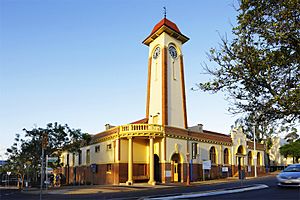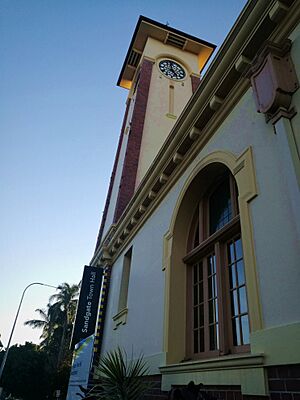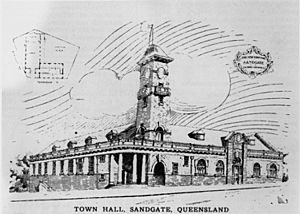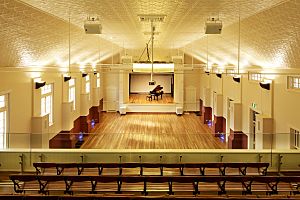Sandgate Town Hall facts for kids
Quick facts for kids Sandgate Town Hall |
|
|---|---|

Sandgate Town Hall, 2012
|
|
| Location | 5 Brighton Road, Sandgate, City of Brisbane, Queensland, Australia |
| Design period | 1900 - 1914 (early 20th century) |
| Built | 1911 - 1912 |
| Built for | Sandgate Town Council |
| Architect | Thomas Ramsay Hall |
| Architectural style(s) | Classicism |
| Owner | Brisbane City Council |
| Official name: Sandgate Town Hall | |
| Type | state heritage (built) |
| Designated | 13 January 1995 |
| Reference no. | 601566 |
| Significant period | 1911-1924 (historical) 1911 - ongoing (social) 1910s (fabric) |
| Significant components | library - chamber/room, hall, views from, furniture/fittings, dress circle, office/s, stage/sound shell, tower - clock, views to |
| Builders | John Gemmell |
| Lua error in Module:Location_map at line 420: attempt to index field 'wikibase' (a nil value). | |
Sandgate Town Hall is a special building in Sandgate, Australia. It's a town hall that has been around for a long time. The building was designed by Thomas Ramsay Hall and built by John Gemmell between 1911 and 1912. It's so important that it's listed on the Queensland Heritage Register, which means it's protected for future generations.
Contents
Why Was Sandgate Town Hall Built?
The Sandgate Town Hall was built because the old town hall burned down on May 24, 1910. The new building cost about £5000, which was a lot of money back then! Thomas Ramsay Hall was the architect who designed it, and John Gemmell was the builder.
How Sandgate Grew as a Town
Europeans first settled in Sandgate in the 1850s. It quickly became a popular seaside holiday spot in Queensland. When the railway arrived in May 1882, even more people came to visit. Sandgate became its own town, called the Town of Sandgate, in 1902. Before that, it was part of other areas.
Choosing a New Location
The first town hall meetings were held in a rented room starting in 1880. The first official Sandgate Town Hall was built in 1882 near the pier. But as Sandgate grew, the town's center moved closer to the Sandgate railway station. So, when the old hall was destroyed by fire in 1910, a new spot was chosen near the railway station and the Sandgate Post Office.
Building the New Town Hall
The first stone for the new Sandgate Town Hall was laid on October 14, 1911, by Sir William MacGregor, who was the Governor of Queensland. John Gemmell built the hall in just eleven months. The total cost, including furniture, was £5000.
Thomas Ramsay Hall, the architect, was also the Town Clerk of Sandgate at the time. Later, he became a very famous architect. He even helped design the Brisbane City Hall!
Design of the Town Hall
The Sandgate Town Hall was designed to stand out on a corner. It's shaped like an "L" with parts extending along two different streets. The main hall is on Brighton Road, and the Council Chambers (where meetings happened) and offices are on Seymour Street. There's also a balcony at the back.
The building has a tall clock tower with three levels. There's space for a clock on the second level and a bell on the third.
Opening Day and the Clock
The Town Hall officially opened on September 21, 1912. Governor William MacGregor was there, and about 500 people came to the ceremony!
The famous four-dial clock was added to the tower in 1923. It came from the Old Ipswich Town Hall and was built in England in 1877. It's believed to be one of the oldest working clocks in Brisbane!
What Happened After 1925?
In 1925, the Town of Sandgate joined with many other local areas to form Greater Brisbane. The Brisbane City Council took over the Sandgate Town Hall. Since then, it has been used as a community hall. It has been a library, a health clinic, and a place for public meetings. Today, the main hall is still used for community events, and the local library operates from the old Council Chambers.
What Does Sandgate Town Hall Look Like?
Sandgate Town Hall is a single-story building made of stone, with a small basement. It has a gabled roof made of corrugated iron. The bottom part of the building is made of brick, and the upper part is covered in a rough plaster called stucco.
It's shaped like an "L" and has a tall, noticeable clock tower where the two parts of the building meet. The tower has brick corners and fancy decorations. A special bell-shaped roof, made of decorative pressed metal, covers the three bells and has a weathervane on top.
The building has different types of windows and doors. The main entrance, at the corner, has two huge Ionic columns. The library entrance on Seymour Street has a decorated wall above it with "SANDGATE TOWN COUNCIL AD 1911" written in a cool, old-fashioned style called Art Nouveau. It also has a large round window with colorful leadlight glass. Other decorations include brick corners, more Art Nouveau signs, and small dormer windows on the roof.
Inside the Town Hall
Inside, you'll find a big hall with a stage, a library, and offices. The main hall has a mezzanine level, which is like a balcony, called a dress circle. It still has some of its old wooden and iron seats. The ceiling of the hall and the arch over the stage are covered with beautiful pressed metal.
You can get to the clock tower from a small entrance behind the dress circle. A wooden ladder leads up to three levels where you can see the clock's parts, weights, and bells.
The library has four different patterns of pressed metal on the ceiling. These patterns show how the room was originally laid out. There's also an old glass door in the library with "THE MAYOR" written on it in the Art Nouveau style.
Why is Sandgate Town Hall Important?
Sandgate Town Hall was added to the Queensland Heritage Register on January 13, 1995, because it's important for several reasons:
- It shows how Queensland's history has changed. The Town Hall helps us understand what Sandgate was like in the late 1800s and early 1900s.
- It's a great example of a certain type of building. Built in 1911-1912, it's a fantastic example of a "Federation style" public building in Queensland. It also shows the amazing work of architect Thomas Ramsay Hall.
- It's beautiful and stands out. The building is a landmark in Sandgate, especially its unique clock tower. It's also an important part of the area that includes the Post Office and Sandgate War Memorial Park.
- It's important to the community. The Town Hall has been a central place for social events and community gatherings for a very long time.




